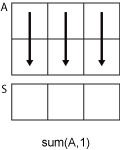sum
数组元素总和
说明
S = sum( 返回 A 沿大小不等于 1 的第一个数组维度的元素之和。A)
如果
A是向量,则sum(A)返回元素之和。如果
A是矩阵,则sum(A)将返回包含每列总和的行向量。如果
A是多维数组,则sum(A)沿大小不等于 1 的第一个数组维度计算,并将这些元素视为向量。此维度中S的大小变为1,而所有其他维度的大小仍与在A中相同。如果
A是表或时间表,则sum(A)返回一个包含每个变量总和的单行表。 (自 R2023a 起)


![sum(A,[1 2]) collapses the pages of a 2-by-3-by-3 array into a 1-by-1-by-3 array.](sum_vecdim.png)